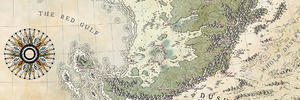Hey All,
This is the second of three Napoleonic Maps I did for Forbidden Games and my friend/owner Glenn Drover.
Short History on the Battle:
Quatre Bras was basically an effort by Napoleon to stop the British/Allied Army of Wellington from aiding Blucher's Prussian army, each of which was smaller, but if combined, would be larger than the Grand Armee'. Both armies were attempting to meet up and combine, and then turn to attack the great general, but of course, he took the initiative. He threw Marshal Ney's army at the British/Allies at the strategic crossroads of QB (which is located SE of Waterloo). Quatre Bras was a victory for the allies (more of a draw), but a strategic victory for Napoleon since it prevented the British from meeting up and aiding the Prussians. On the same day as QB, Napoleon engaged and defeated the Prussians at Ligny. Because the allies retained the battlefield at QB (despite losing more men), it did buy time for the bulk of the army to fall back in good order to defensive heights at Waterloo, so in an sense, it could also be considered a strategic victory as well. Thinking the Prussians had been knocked out of the fight completely do to his crushing victory (at Ligny), he turned and advanced on the smaller British/Allied army at Waterloo, opening the battle two days later. Unbeknownst to Napoleon, the Prussians had recovered from their defeat, and were determined to aid Wellington. They rallied, and marched west to the aid of the allies who had at that point been engaged. When Napoleon heard of this, he dispatched a corps to try and hold them up as long as they could so he could rout the British, and then turn once again on the Prussians, but this was not to be.
From my earlier post:
This map, and the others (Ligny and Waterloo) represent many hours of research and positioning to give the viewer a good idea of the approximate locations and tactical situation of the battle at a certain point in time. Glenn wanted me to emulate classic maps of the period (such that they were) and thus I had to merge several styles together (most notably taking inspiration from the ACW) to give both a historically appealing as well as understandable look to each. I developed a few brushes to help me speed up the process, since drawing every single mark would have driven me quite insane. Even so, the files were quite massive and the relative simplicity of the look belies their complex nature.
The positioning of the landmarks, troop strengths, commanders, battalions was all very fascinating, and in this case, even inches could matter greatly. I used a great number of old maps, and old books to try and triangulate unit placement, as well as hand written notes/revisions from Glenn himself to correctly place everything.
Comments and Critiques welcome,
~Blando










 Reply With Quote
Reply With Quote











